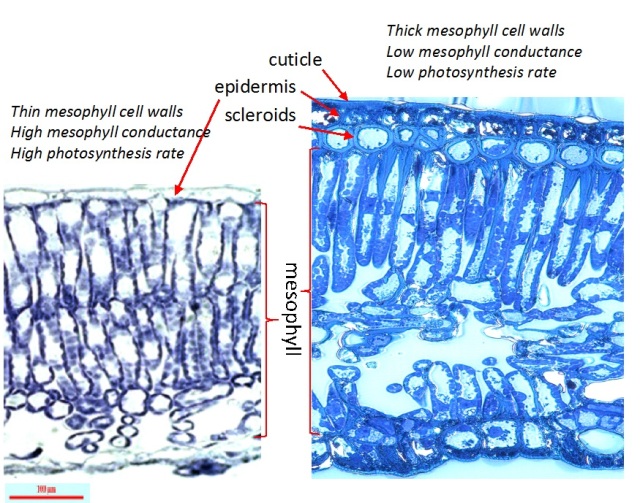autor Anton Zolotarjov
autor Anton Zolotarjov
autor Linda-Liisa Veromann-Jürgenson
autor Kersti Püssa
autor Anton Zolotarjov
autor Anton Zolotarjov
autor Linda-Liisa Veromann-Jürgenson
autor Kersti Püssa
In the world-wide leaf economics spectrum (Wright et al. 2004, Nature) variability of three key traits: photosynthesis rate, leaf nitrogen content, and leaf dry mass per area of 2500 species (from study sites with highly variable mean annual humidity and temperature) fall along the single axis of this three-trait space. However, the striking question has been what actually is the parameter that drives LES relationships.
Meta-analysis (lead by Dr. Yusuke Onoda from Kyoto University) confirms the speculations that this variation is caused by variable mesophyll conductance (e.g. CO2 diffusion efficiency from sub-stomatal cavities to chloroplasts) and different life strategies in terms of nitrogen investment into structural cell wall material rather than photosynthetic biochemistry (see the figure below).

Illustration of structure-function relationships of two species with contrasting life strategies. Left: temperate decidous pioneer species Populus tremula and right side: evergreen Cycas taitungensis. Mesophyll tissue, epidermis, scleroids and cuticle are shown. Populus tremula leaf is positioned to fast return end of LES. Populus invests proportionally less resources into protective cells (scleroids, cuticle, thick mesophyll cell walls) rather it invests into building 2 layers of thick physiologically active palisade tissue this in turn brings to high photosynthesis and fast growth rate while Cycads have proportionally more C and N invested into protective structural cells and therefore lower photosynthesis and slower growth rate. However, in longer perspective Cycas has longer leaf life span and slower energy return. That is, more nitrogen invested into cell walls means more durable and tougher leaves. On the other hand thick mesophyll cell walls represent longer liquid phase distance through cell walls (low mesophyll conductance) into the chloroplasts and therefore less efficient photosynthesis
Citation: Onoda, Y., Wright, I. J., Evans, J. R., Hikosaka, K., Kitajima, K., Niinemets, Ü., Poorter, H., Tosens, T. & Westoby, M. (2017). Physiological and structural tradeoffs underlying the leaf economics spectrum. New Phytologist, 214(4), 1447-1463. (link to full text)
Check also out a commentary titled “Peeking beneath the hood of the leaf economics spectrum” by by Reich and Flores-Moreno (link to full text) who emphasize the significance of this study: “What is most novel about their study is the bringing together of considerable data on rarely measured leaf traits, assessing both chemical (e.g. nitrogen (N) allocation) and diffusive (mesophyll conductance) constraints at the same time, and identifying a key role for cell-wall thickness in both of these.“
Abstract: